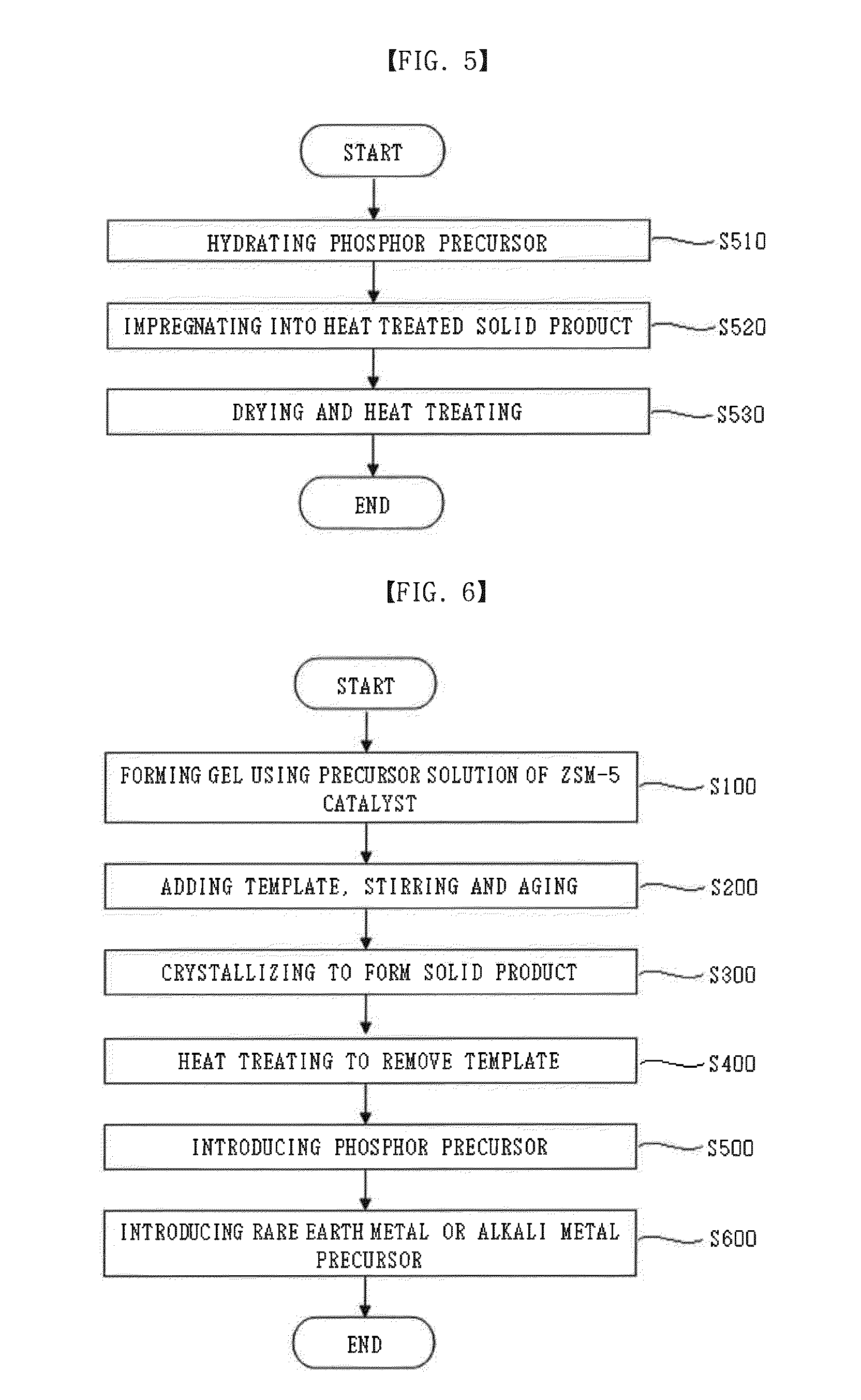ZSM-5 catalyst with micropores and mesopores, preparation method thereof and production method of light olefins through catalytic cracking of hydrocarbons using the catalyst
a technology of hydrocarbon cracking and catalyst, which is applied in the field of zsm5 catalyst with micropores and mesopores, a preparation method thereof, and a production method of light olefins through catalytic cracking of hydrocarbons using the catalyst, can solve the problems of low catalytic activity, high energy consumption ratio through the production of light olefins, and large amount of carbon dioxide to induce environmental contamination. , to achieve the effect o
- Summary
- Abstract
- Description
- Claims
- Application Information
AI Technical Summary
Benefits of technology
Problems solved by technology
Method used
Image
Examples
first embodiment
[0094]FIG. 1 is a flow chart for explaining a preparation method of a microporous and mesoporous ZSM-5 catalyst in accordance with a First Embodiment of the present inventive concept, FIG. 2 is a flow chart for explaining a process of preparing a mixture solution at step (a) in a preparation method of a microporous and mesoporous ZSM-5 catalyst in accordance with the present inventive concept, and FIG. 3 is a flow chart for explaining a process of replacing a heat-treated solid product with a cation in a preparation method of a microporous and mesoporous ZSM-5 catalyst in accordance with the present inventive concept.
[0095]Referring to FIG. 1, in accordance with a method of preparing a microporous and mesoporous ZSM-5 catalyst in the First Embodiment, the method of preparing the microporous and mesoporous ZSM-5 catalyst includes (a) forming a gel by aging a mixture solution of a silica precursor and an aluminum precursor (Step S100); (b) adding a template possibly forming mesopores ...
second embodiment
[0116]FIG. 4 is a flow chart for explaining a preparation method of a microporous and mesoporous ZSM-5 catalyst in accordance with a Second Embodiment of the present inventive concept, and FIG. 5 is a flow chart for explaining an impregnating process of a phosphor precursor in a preparation method of a microporous and mesoporous ZSM-5 catalyst in accordance with the present inventive concept.
[0117]Referring to FIG. 4, a method of preparing a ZSM-5 catalyst with micropores and mesopores in accordance with the Second Embodiment includes (a) forming a gel by aging a mixture solution including a silica precursor and an aluminum precursor (Step S100); (b) adding a template into the gel, stirring and then aging (Step S200); (c) forming a solid product by crystallizing the aged mixture in step (b) (Step S300); (d) heat treating the solid product to remove the template (Step S400); and (e) introducing a phosphor precursor into the heat treated solid product through an impregnation method or...
third embodiment
[0128]FIG. 6 is a flow chart for explaining a preparation method of a microporous and mesoporous ZSM-5 catalyst in accordance with a Third Embodiment of the present inventive concept, and FIG. 7 is a flow chart for explaining an impregnating process of a rare earth metal precursor or an alkali metal precursor a preparation method of a microporous and mesoporous ZSM-5 catalyst in accordance with the present inventive concept.
[0129]Referring to FIG. 6, a method of preparing a ZSM-5 catalyst with micropores and mesopores in accordance with the Third Embodiment includes (a) forming a gel by aging a mixture solution including a silica precursor and an aluminum precursor (Step S100); (b) adding a template into the gel, stirring and then aging (Step S200); (c) forming a solid product by crystallizing the aged mixture in step (b) (Step S300); (d) heat treating the solid product to remove the template (Step S400); (e) introducing a phosphor precursor into the heat treated solid product throu...
PUM
| Property | Measurement | Unit |
|---|---|---|
| diameter | aaaaa | aaaaa |
| temperature | aaaaa | aaaaa |
| temperature | aaaaa | aaaaa |
Abstract
Description
Claims
Application Information
 Login to View More
Login to View More - R&D
- Intellectual Property
- Life Sciences
- Materials
- Tech Scout
- Unparalleled Data Quality
- Higher Quality Content
- 60% Fewer Hallucinations
Browse by: Latest US Patents, China's latest patents, Technical Efficacy Thesaurus, Application Domain, Technology Topic, Popular Technical Reports.
© 2025 PatSnap. All rights reserved.Legal|Privacy policy|Modern Slavery Act Transparency Statement|Sitemap|About US| Contact US: help@patsnap.com



